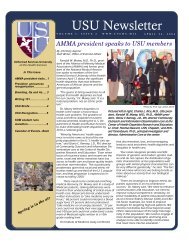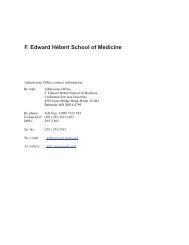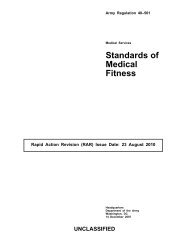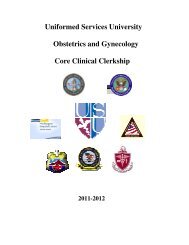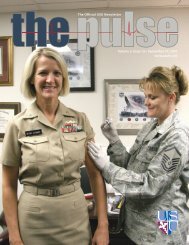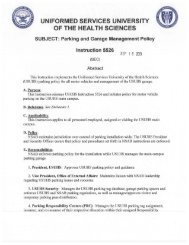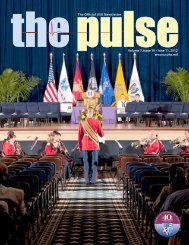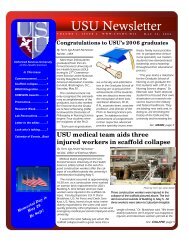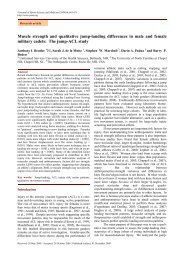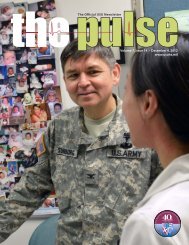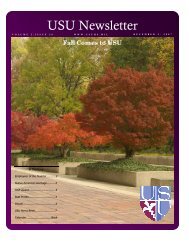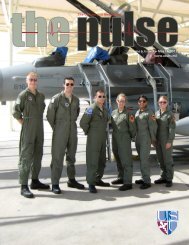Looking AheadU.S. academic medicine is facing a myriad <strong>of</strong>challenges—a predicted 30 percent shortfall in <strong>the</strong>number <strong>of</strong> physicians within <strong>the</strong> next 20 years; fewercompetitive undergraduates applying to medicalschool; concern about student debt and its limitation<strong>of</strong> choice <strong>of</strong> practice; continued lack <strong>of</strong> diversityamong student bodies; curricula taxed by <strong>the</strong>ever-growing complexity and scientific challenges <strong>of</strong>medical practice; and <strong>the</strong> challenge and practicalityfor faculty <strong>of</strong> balancing <strong>the</strong> enormous demands <strong>of</strong>acting as physician, teacher and scientist. At <strong>the</strong> sametime, health care and biomedical research have neverbeen more exciting and fulfilling.USU faces many <strong>of</strong> <strong>the</strong> same issues as civilianacademic health centers, with <strong>the</strong> critical differencethat USU students face nei<strong>the</strong>r debt nor limits onpractice and career. The university’s curriculumis, and has always been, focused on keepingtroops healthy. This gives a special niche that<strong>the</strong> university will continue to emphasize in bo<strong>the</strong>ducation and research programs. The university isat an extraordinary moment in history. Due to <strong>the</strong>recommendations <strong>of</strong> <strong>the</strong> 2005 Base Realignmentand Closure committee, <strong>the</strong> DoD will create on thiscampus, and with USU as its educational core, <strong>the</strong>“academic health center <strong>of</strong> <strong>the</strong> 21 st Century.” Leadersin <strong>the</strong> National Capital Area are hard at workdeveloping <strong>the</strong> new Walter Reed National MilitaryMedical Center (WRNMMC), scheduled to openon <strong>the</strong> National Naval Medical Center campus—<strong>the</strong>home <strong>of</strong> USU—in 2011.USU’s role in this new medical center presents atremendous opportunity not only for <strong>the</strong> Military<strong>Health</strong> System, but also for <strong>the</strong> nation’s academichealth system. The joining <strong>of</strong> four uniformed services,co-located with a health sciences university, on acampus adjacent to <strong>the</strong> National Institutes <strong>of</strong> <strong>Health</strong>,with its unparalled research and clinical services, willallow U.S. medicine to create a new model <strong>of</strong> anacademic health center. WRNMMC will be a focalpoint <strong>of</strong> federal investment in <strong>the</strong> health sciences at asingle site and will allow USU to provide an educationfor future uniformed services practitioners andresearchers that is informed by <strong>the</strong> very latest researchon emerging health problems.The DoD will create on thiscampus, and with USU asits educational core, <strong>the</strong>“academic health center <strong>of</strong><strong>the</strong> 21 st Century.”Success will depend largely on flexibility andinnovation. The university must learn to cross withgrace and ease <strong>the</strong> boundaries <strong>of</strong> service—Army,Navy, Air Force or Public <strong>Health</strong> Service, within andbeyond <strong>the</strong> Department <strong>of</strong> Defense and Department<strong>of</strong> <strong>Health</strong> and Human <strong>Services</strong>. It must engagecivilian academic health centers in meaningfulpartnerships and connect with NIH researchers, grant<strong>the</strong>m access to <strong>the</strong> military’s extraordinary clinicalresearch population and databases, and in turn gainexpanded access for <strong>the</strong> military system to state-<strong>of</strong><strong>the</strong>-arttreatment and protocols.The nation has invested billions <strong>of</strong> dollars in publichealth. The creation <strong>of</strong> WRNMMC is a first step inpooling resources and developing shared visions toserve a single mission—ensuring military and publichealth worldwide.Members <strong>of</strong> <strong>the</strong> original2006 – 2007 flag council forNational Capital Area integrationefforts included: (left toright) Major General KennethFarmer, Jr., M.D., CommandingGeneral, North Atlantic RegionalMedical Command; CharlesRice, M.D., USU President; RearAdmiral Adam Robinson, M.D.,Commander, National NavalMedical Center; BrigadierGeneral Thomas Travis, M.D.,Commander, 79th Medical Wing.32
®USU LeadershipPresidentCharles L. Rice, M.D.Chief <strong>of</strong> StaffStephen Henske, M.H.A., CAPT, MSC, USN (Ret)Special Assistant, Bldg. EMary A. Dix, B.S., M.S.Special Assistant, BRAC IntegrationVernon D. Schinski, Ph.D.CAPT, MSC, USN (Ret)Dean, F. Edward Hébert School <strong>of</strong> MedicineLarry W. Laughlin, M.D., Ph.D.CAPT, MC, USN (Ret)Vice DeanCol John McManigle,USAF, MCAssociate Dean for Graduate EducationEleanor S. Metcalf, Ph.D.Associate Dean for Graduate Medical EducationHoward E. Fauver, Jr., M.D., COL, MC, USA (Ret)Associate Dean for Student AffairsRichard MacDonald, M.D., COL, MC, USA (Ret)Commandant, School <strong>of</strong> MedicineCol. Ken Tashiro, USAF, MC(Acting) Dean Graduate School <strong>of</strong> NursingWilliam Bester, R.N., MSN, C.N.A.A., BCBG, AN, USA (Ret)Associate Dean for Faculty AffairsKaren L. Elberson, Ph.D., R.N.Vacant (October 1, 2007 – present)Assistant Dean for Student Affairs/CommandantLTC Wanda D. Jenkins, AN, USADirector, Armed Forces Radiobiology Research InstituteCOL Patricia K. Lillis-Hearne, MC, USADirector, U.S. Military Cancer InstituteJohn Potter, M.D.(Acting) Senior Vice PresidentDale C. Smith, Ph.D.Vice President for Recruitment and DiversityCAPT Cynthia Macri, MC, USNVice President, Affiliations and International AffairsEmmanuel G. Cassimatis, M.D.COL, MC, USA (Ret)Senior Executive Director, Continuing Education for<strong>Health</strong> Pr<strong>of</strong>essionals DirectorateCAPT Jaime Luke, NC, USNVice President for External AffairsCarol R. Scheman, M.S.S.A.Vice President for Finance and AdministrationStephen C. Rice, M.S., F.A.C.H.E.CAPT, MSC, USN (Ret)Vice President for ResearchSteven G. Kaminsky, Ph.D.Brigade CommanderLTC John Maurer, MS, USACOL John Wempe, MC, USA (August 2007 – present)General CounselJohn E. Baker, J.D., LL.M., COL, JA, USA (Ret)Faculty Senate PresidentBob Williams, Ph.D.F. Edward Hébert School <strong>of</strong> MedicineAcademic Department Chairs/Program DirectorsDepartment <strong>of</strong> Anatomy, Physiology and GeneticsChair: Harvey B. Pollard, M.D., Ph.D., CAPT, USPHS (Ret)Department <strong>of</strong> Anes<strong>the</strong>siology(Acting) Chair: LTC(P) Cynthia H. Shields, MC, USADepartment <strong>of</strong> Biochemistry and Molecular BiologyChair: Teresa Dunn, Ph.D.Department <strong>of</strong> Biomedical InformaticsChair: A. Leon Moore, Ph.D.Department <strong>of</strong> DermatologyChair and Pr<strong>of</strong>essor: Leonard B. Sperling, M.D.COL, MC, USA (Ret)Department <strong>of</strong> Family MedicineChair: Col Brian V. Reamy, USAF, MCDepartment <strong>of</strong> Medical and Clinical PsychologyChair: David S. Krantz, Ph.D.Department <strong>of</strong> Medical HistoryChair: Dale C. Smith, Ph.D.Department <strong>of</strong> MedicineChair: Robert Goldstein, M.D.(Acting) Chair: Brian Monahan, M.D.(September 2007 – present)Department <strong>of</strong> Microbiology and ImmunologyChair: Alison D. O’Brien, Ph.D.Department <strong>of</strong> Military and Emergency MedicineChair: CAPT Trueman W. Sharp, MC, USNDepartment <strong>of</strong> NeurologyChair: COL William W. Campbell, Jr., MC, USADepartment <strong>of</strong> Obstetrics and GynecologyChair: Andrew Satin, M.D., Col, USAF, MC (Ret)(Acting) Chair: Col Christopher Zahn, USAF, MC(September 2007 – present)Department <strong>of</strong> PathologyChair: Robert M. Friedman, M.D., CAPT, USPHS (Ret)Department <strong>of</strong> PediatricsChair: Ildy M. Katona, M.D., CAPT, MC, USN (Ret)Department <strong>of</strong> PharmacologyChair: Brian M. Cox, Ph.D.Department <strong>of</strong> Preventive Medicine and BiometricsChair: CAPT Gerald V. Quinnan, USPHSDepartment <strong>of</strong> PsychiatryChair: Robert J. Ursano, M.D., Col, USAF, MC (Ret)Department <strong>of</strong> Radiation BiologyChair: Terry C. Pellmar, Ph.D.Department <strong>of</strong> Radiology and Nuclear MedicineChair: James G. Smirniotopoulos, M.D.Department <strong>of</strong> SurgeryChair: COL David G. Burris, MC, USAEmerging Infectious Diseases ProgramDirector: Christopher C. Broder, Ph.D.Molecular and Cell Biology ProgramDirector: Jeffrey M. Harmon, Ph.D.Neuroscience ProgramDirector: Regina Armstrong, Ph.D.Section <strong>of</strong> Medical JurisprudenceBradley S. Beall, J.D., CDR, JAGC, USN (Ret)Graduate School <strong>of</strong> NursingAcademic Department Chairs/Program DirectorsDepartment <strong>of</strong> <strong>Health</strong> Systems, Risk and ContingencyManagementChair: Sandra C. Bibb, D.N.Sc., R.N.Department <strong>of</strong> <strong>Health</strong>, Injury and Disease ManagementChair: Diane Padden, Ph.D., C.R.N.P.Family Nurse Practitioner ProgramDirector: Diane Seibert, Ph.D., C.R.N.P.Perioperative Clinical Nurse Specialist ProgramDirector: COL Linda J. Wanzer, AN, USANurse Anes<strong>the</strong>sia ProgramDirector: Lt Col Adrienne Hartgerink, USAF, NCNursing Science ProgramKaren L. Elberson, Ph.D., R.N.(Acting) Director: Christine Kasper, Ph.D., R.N. (August2007 – present)Psychiatric Mental <strong>Health</strong> ProgramMAJ Robert Arnold, AN, USABoard <strong>of</strong> RegentsChairThe Honorable Everett Alvarez, Jr.Vice ChairThe Honorable Linda J. StierleMembersThe Honorable Otis W. BrawleyThe Honorable Colleen Conway-WelchThe Honorable William DeLaPeñaThe Honorable Sharon A. Falkenheimer(Resigned July 31, 2007)The Honorable Vinicio E. MadrigalThe Honorable Lawrence C. Mohr, Jr.The Honorable C. Thomas Yarington, Jr.(Deceased May 30, 2007)Ex-Officio MembersThe Honorable S. Ward CasscellsAssistant Secretary <strong>of</strong> Defense for <strong>Health</strong> AffairsCharles L. Rice, M.D.President, USUVADM Donald C. Arthur (July 2004 - August 27, 2007)Surgeon General, United States NavyVADM Adam M. Robinson (August 27, 2007 – present)Surgeon General, United States NavyLt Gen James G. Roudebush, USAF, MCSurgeon General, United States Air ForceRADM Kenneth P. Moritsugu, USPHS(Acting) Surgeon General <strong>of</strong> <strong>the</strong> United StatesMG Gale S. Pollock, AN, USA(Acting) Surgeon General, United States ArmyProduced by




